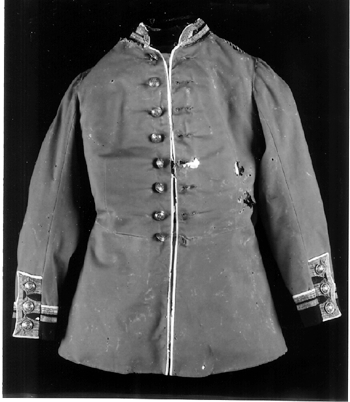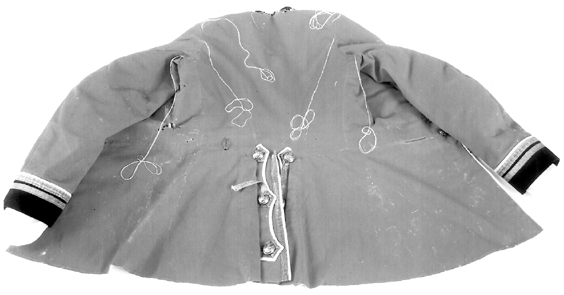CONSERVATION OF A MILITARY TUNIC INCLUDING THE USE OF GUIDE THREADS FOR POSITIONING REPAIRS
JAN VUORI, & ROBIN HANSON
1 1. INTRODUCTION
A single-breasted, full-dress military tunic dating from the mid-1860s was submitted by the Lundy's Lane Historical Museum in Niagara Falls, Ontario, Canada, for treatment in the textile laboratory of the Canadian Conservation Institute (CCI) (figs. 1 and 2. Also see fig. 6). Based on information received from the museum, this tunic was worn by a member of the 44th Welland Battalion of Infantry, a voluntary militia organized in and around Niagara Falls, Ontario, in November 1866, to defend against the Fenian raids. The Fenians were a group of Irish and Irish-Americans dedicated to the overthrow of British rule in Ireland. Small bands of Fenians made several raids from the United States into Canada that were driven back. The collar lining contains a name tag that is difficult to read but appears to say “[illegible] S. Barnett,” and so it is probable that this tunic belonged to Captain Sidney Barnett, founder of a volunteer militia unit formed to defend Canada from Fenian raiders.
Fig. 1.
Military tunic before treatment. Collection of Lundy's Lane Historical Museum, Niagara Falls, Ontario. Courtesy of Canadian Conservation Institute
 |
Fig. 2.
Interior of tunic before treatment. Courtesy of Canadian Conservation Institute
 |
Fig. 6.
Guide threads for positioning new lining drawn through corresponding points of tunic. Courtesy of Canadian Conservation Institute
 |
The tunic is a primary article of military dress and provides a certain amount of information about the wearer. Decoration on the cuffs, collar, and shoulders provides clues as to the owner's rank; collar badges and the button pattern provide clues as to the wearer's unit. At the time this tunic was made, it was standard to decorate militia uniforms with silver lace and buttons, whereas gold lace and buttons were used on the uniforms of officers in the regular forces (Tyler 1984). Lace refers to the flat ribbon woven in gold or silver wire or colored silk or cotton thread and used to denote rank (Ross and Chartrand 1977). Shoulder cords also were standard on militia uniforms; the cord seen on the proper left (PL) shoulder of this tunic indicates the rank of lieutenant or captain. Due to the tunic's extremely poor condition, both structural and aesthetic, the museum was prevented from displaying it. Indeed, the tunic could not withstand handling for study purposes without the risk of additional damage.
|


